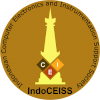Integration of Augmented Reality and Voice Recognition in Learning English for Children
Abstract
Full Text:
PDFReferences
Franciska, M. B., Setyawan, M. B., & Zulkarnain, I. A. (2018). Rancang Bangun Media Pembelajaran Bahasa Inggris Berbasis Android Menggunakan Teknologi Augmented Reality Untuk Sekolah Dasar (Studi Kasus Mi Ma’Arif Patihan Kidul). Komputek, 2(2), 48.
Syahidi, A. A., Tolle, H., Supianto, A. A., & Arai, K. (2019). BandoAR: Real-Time Text Based Detection System Using Augmented Reality for Media Translator Banjar Language to Indonesian with Smartphone. 2018 IEEE 5th International Conference on Engineering Technologies and Applied Sciences, ICETAS 2018, 1–6.
Anggraini, N., Kurniawan, A., Wardhani, L. K., & Hakiem, N. (2018). Speech Recognition Application for the Speech Impaired using the Android-based Google Cloud Speech API. 16(6).
Aouam, D., Benbelkacem, S., Zenati, N., Zakaria, S., & Meftah, Z. (2018). Voice-based Augmented Reality Interactive System for Car’s Components Assembly. Proceedings - PAIS 2018: International Conference on Pattern Analysis and Intelligent Systems, 1–5.
Wijaya, S., & Wicaksana, A. (2019). JACOB voice chatbot application using wit.Ai for providing information in UMN. International Journal of Engineering and Advanced Technology, 8(6 Special Issue 3), 105–109.
Agustini, M., Yufiarti, & Wuryani. (2020). Development of learning media based on android games for children with attention deficit hyperactivity disorder. International Journal of Interactive Mobile Technologies, 14(6), 205–213.
Ahmad, A., Hadiansa, A., Hidayatullah, R., Informatika, J. T., Informatika, J. M., & Informatika, J. T. (2018). L e n t e r a d u m a i ,. 9, 42–46.
Akrim, M. (2018). Media Learning in Digital Era. 231(Amca), 458–460.
Billinghurst, M., Clark, A., & Lee, G. (2014). A Survey of Augmented Reality Foundations and Trends R in Human-Computer Interaction. Human-Computer Interaction, 8(3), 73–272. CS4HS 2016 The University of Queensland. (2016).
Faqih, M., & Kusumaningsih, A. (2018). PENERAPAN AUGMENTED REALITY PADA SERIOUS GAME EDUKASI PENYAKIT GIGI. 9(2), 1033–1042.
Hashim, N. C., Majid, N. A. A., Arshad, H., & Obeidy, W. K. (2018). User Satisfaction for an Augmented Reality Application to Support Productive Vocabulary Using Speech Recognition. Advances in Multimedia, 2018.
Megista Putri, D., & Rasmita, R. (2019). Upaya Meningkatkan Minat Belajar Bahasa Inggris Siswa Sekolah Dasar (Sd) Negeri 13 Padang Menggunakan Metode “Total Physical Response.” Jurnal Kepemimpinan Dan Pengurusan Sekolah, 4(1), 11–18.
Musthafa, B. (2010). Teaching English to Young Learners in Indonesia : Essential Requirements. Educationist, IV(2), 120–125.
Saputra, D. S. (2017). Interactive Learning Dalam Pembelajaran Speaking Di Kelas V Sekolah Dasar. Jurnal Cakrawala Pendas, 3(1).
Simonetti, Alexandro;Paredes, J. (2016). Vuforia v1.5 SDK: Analysis and evaluation of capabilities. Medicina Clinica, 147(9), 393–396.
Waliyuddin, M. H., Sukamto, A. S., & Anra, H. (2019). Rancang Bangun Aplikasi Panorama Wisata Kota dalam Upaya Pengenalan Budaya dan Pariwisata Kota Pontianak. Jurnal Sistem Dan Teknologi Informasi (JUSTIN), 7(2), 113.
DOI: https://doi.org/10.33633/jais.v7i2.6119
Article Metrics
Abstract view : 392 timesPDF - 210 times
Refbacks
- There are currently no refbacks.
Journal of Applied Intelligent System (e-ISSN : 2502-9401, p-ISSN : 2503-0493) is published by Department of Informatics Universitas Dian Nuswantoro Semarang and IndoCEISS.


Journal of Applied Intelligent System indexed by :
This journal is under licensed of Creative Commons Attribution 4.0 International License.

_.png)






